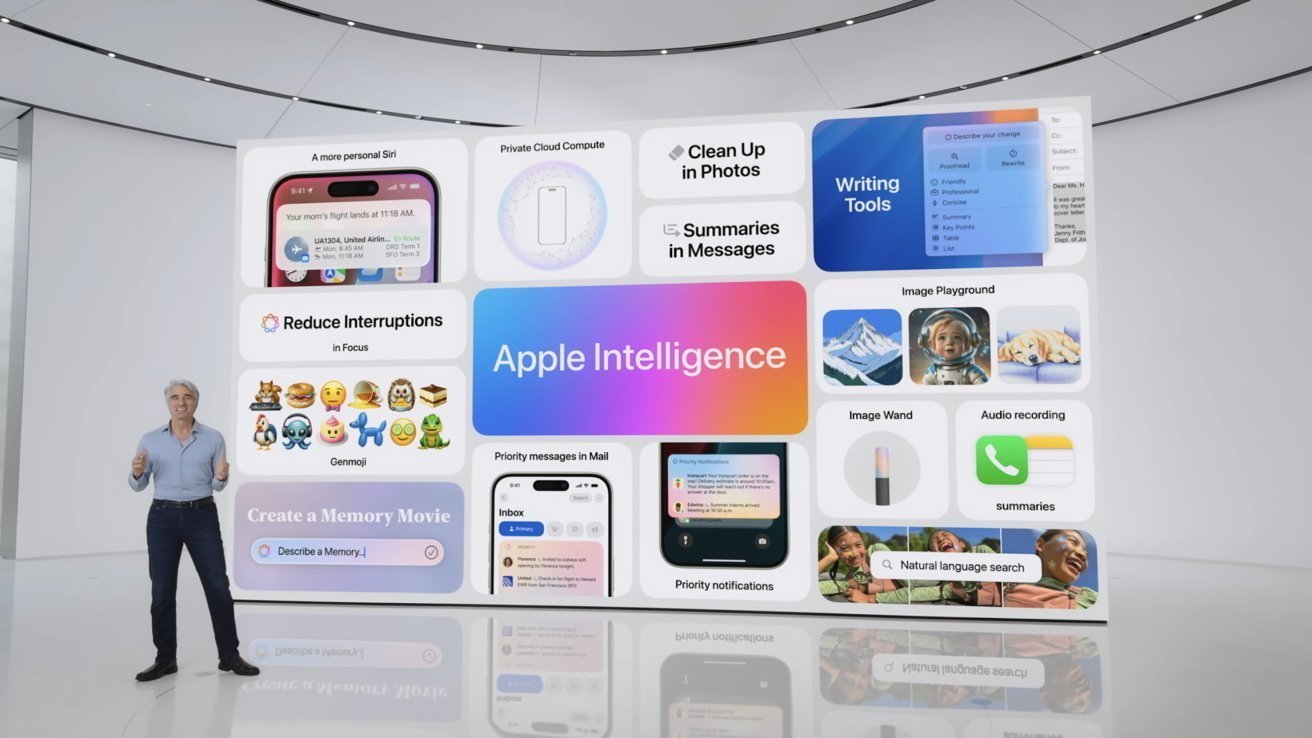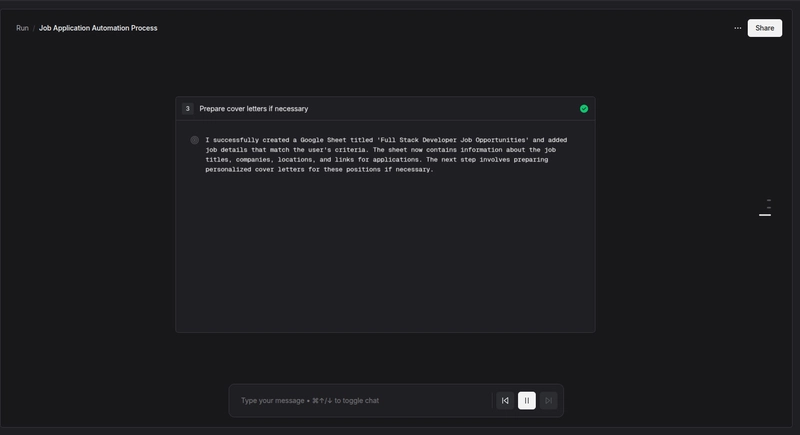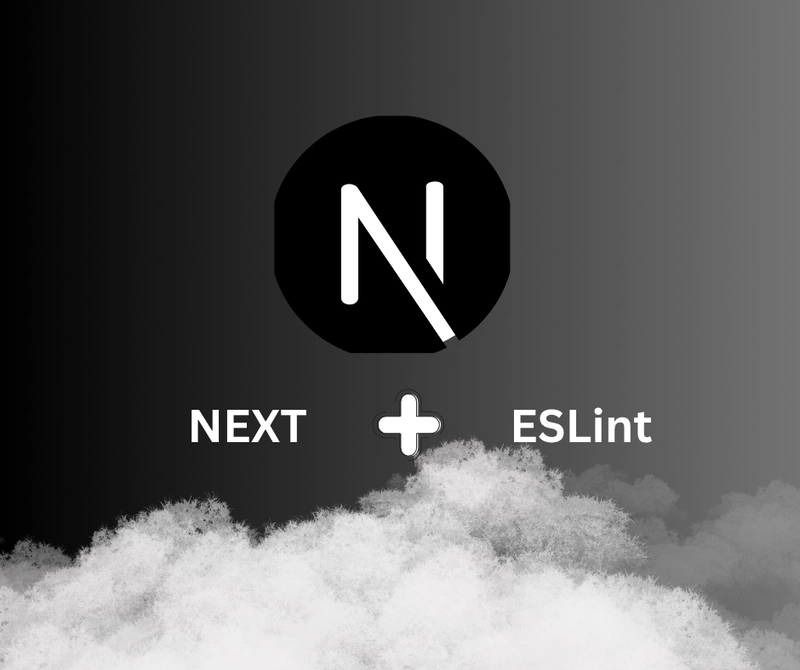I create agent using Runner H to get hired in 2025
What I Built JobHunter AI I automated the entire job-hunting and applying process for fresher-level full stack developers using Runner H. The goal was to cut down the time spent manually checking job boards, filtering relevant roles, filling forms, and organizing applications — especially for entry-level candidates targeting remote or metro-city jobs. The workflow tackles the following pain points: Scanning and scraping jobs from multiple sites that allow entry-level filters. Filtering based on location (Remote, Delhi, Bangalore, Noida) and tech stack (MERN, AWS). Storing all relevant job details in a Google Sheet in a structured format. Optionally applying to each job with a predefined resume and custom message. Tracking application status per job. With a single trigger, the agent fetches fresh job leads, updates the spreadsheet, and optionally auto-applies — freeing up time to focus on interview prep and upskilling. Demo How I Used Runner H Prompt Design & AI Integration The heart of the automation is this custom prompt: First i write myself then i rewrite and detailed using the ChatGPT. You are a Job Application Agent designed to help users find relevant job postings and apply to them efficiently. Your tasks follow a structured multi-step process. Your goal: Automatically search for jobs that match the user's profile, extract important job data (like title, company, link, and requirements), and apply or prepare application steps (like saving to a Google Sheet, writing cover letters, or submitting via form/email). Follow this step-by-step system: STEP 1: Understand the User Profile Ask for the user’s job preferences: * Job titles (e.g., “Frontend Developer”, “ML Engineer”) * Locations (remote, cities, countries) * Experience level (e.g., fresher, 1–3 years) * Preferred tech stack or skills * Resume/LinkedIn link (if available) STEP 2: Job Scraping * Scrape jobs from platforms like: * LinkedIn Jobs (if allowed) * Wellfound (AngelList) * Indeed, HackerRank, RemoteOK, or Workat startups * Use filters based on STEP 1 * Extract the following: * Job title * Company name * Location * Tech stack or skill match * Job link * Posted date STEP 3: Save or Apply * If job meets criteria, either: * Add details to a structured Google Sheet with columns like: * \[Job Title | Company | Location | Skills | Link | Apply Status | Notes] * Or auto-apply using the resume and fill in cover letters * Use LinkedIn Easy Apply if available * Ask user if manual application is needed STEP 4: Cover Letter Draft (if needed) * Write a personalized cover letter for the selected job * Use user’s resume + job description to match tone, skills, and motivation STEP 5: Status Tracking * Update Google Sheet with "Applied", "Skipped", or "Pending" * Avoid duplicate applications * Save timestamps of activity Rules: * Do not apply without explicit user approval * Always confirm before sending emails or filling forms * Keep all logs in an organized sheet * Prioritize quality over quantity (only relevant jobs) Tone: Efficient, helpful, professional. Once the user provides their preferences, begin the scraping process. Automation Actions Web Scraping/API Calls: Pulls job listings matching the filter criteria. Google Sheets Integration: Stores all job data row-by-row. Auto-Apply Logic: Optionally fills forms with resume + intro note. Status Update: Marks each job as ‘applied’ or ‘saved’ depending on action taken. Result Runner H Agent Flow Summary: Trigger: Daily or on-demand AI Task: Extract & filter job listings Storage: Save to Google Sheets Optional Action: Auto-apply to selected jobs Use Case & Impact This automation is ideal for: Fresh graduates looking to break into tech without manually sifting through job boards. Bootcamp grads or self-taught devs targeting remote-first roles. Developers applying to 10+ jobs a day and tired of repetitive forms. Mentors/coaches helping students track and apply efficiently. Benefits: Time Saved: Replaces 1–2 hours of job search & apply effort daily. Precision: Matches your tech stack and preferred locations. Consistency: Every opportunity logged with a clear structure. Scalability: Easily expandable to other roles or apply logic. Social Love I’m sharing this project on Twitter and inviting others to build smart career workflows. Twitter Post My Runner H Chat Let's Connect me on LinkedIn Linkedin Github Portfolio

What I Built
JobHunter AI
I automated the entire job-hunting and applying process for fresher-level full stack developers using Runner H. The goal was to cut down the time spent manually checking job boards, filtering relevant roles, filling forms, and organizing applications — especially for entry-level candidates targeting remote or metro-city jobs.
The workflow tackles the following pain points:
- Scanning and scraping jobs from multiple sites that allow entry-level filters.
- Filtering based on location (Remote, Delhi, Bangalore, Noida) and tech stack (MERN, AWS).
- Storing all relevant job details in a Google Sheet in a structured format.
- Optionally applying to each job with a predefined resume and custom message.
- Tracking application status per job.
With a single trigger, the agent fetches fresh job leads, updates the spreadsheet, and optionally auto-applies — freeing up time to focus on interview prep and upskilling.
Demo
How I Used Runner H
Prompt Design & AI Integration
The heart of the automation is this custom prompt:
First i write myself then i rewrite and detailed using the ChatGPT.
You are a Job Application Agent designed to help users find relevant job postings and apply to them efficiently. Your tasks follow a structured multi-step process.
Your goal: Automatically search for jobs that match the user's profile, extract important job data (like title, company, link, and requirements), and apply or prepare application steps (like saving to a Google Sheet, writing cover letters, or submitting via form/email).
Follow this step-by-step system:
STEP 1: Understand the User Profile
Ask for the user’s job preferences:
* Job titles (e.g., “Frontend Developer”, “ML Engineer”)
* Locations (remote, cities, countries)
* Experience level (e.g., fresher, 1–3 years)
* Preferred tech stack or skills
* Resume/LinkedIn link (if available)
STEP 2: Job Scraping
* Scrape jobs from platforms like:
* LinkedIn Jobs (if allowed)
* Wellfound (AngelList)
* Indeed, HackerRank, RemoteOK, or Workat startups
* Use filters based on STEP 1
* Extract the following:
* Job title
* Company name
* Location
* Tech stack or skill match
* Job link
* Posted date
STEP 3: Save or Apply
* If job meets criteria, either:
* Add details to a structured Google Sheet with columns like:
* \[Job Title | Company | Location | Skills | Link | Apply Status | Notes]
* Or auto-apply using the resume and fill in cover letters
* Use LinkedIn Easy Apply if available
* Ask user if manual application is needed
STEP 4: Cover Letter Draft (if needed)
* Write a personalized cover letter for the selected job
* Use user’s resume + job description to match tone, skills, and motivation
STEP 5: Status Tracking
* Update Google Sheet with "Applied", "Skipped", or "Pending"
* Avoid duplicate applications
* Save timestamps of activity
Rules:
* Do not apply without explicit user approval
* Always confirm before sending emails or filling forms
* Keep all logs in an organized sheet
* Prioritize quality over quantity (only relevant jobs)
Tone: Efficient, helpful, professional.
Once the user provides their preferences, begin the scraping process.
Automation Actions
- Web Scraping/API Calls: Pulls job listings matching the filter criteria.
- Google Sheets Integration: Stores all job data row-by-row.
- Auto-Apply Logic: Optionally fills forms with resume + intro note.
- Status Update: Marks each job as ‘applied’ or ‘saved’ depending on action taken.
Result
Runner H Agent Flow Summary:
- Trigger: Daily or on-demand
- AI Task: Extract & filter job listings
- Storage: Save to Google Sheets
- Optional Action: Auto-apply to selected jobs
Use Case & Impact
This automation is ideal for:
- Fresh graduates looking to break into tech without manually sifting through job boards.
- Bootcamp grads or self-taught devs targeting remote-first roles.
- Developers applying to 10+ jobs a day and tired of repetitive forms.
- Mentors/coaches helping students track and apply efficiently.
Benefits:
- Time Saved: Replaces 1–2 hours of job search & apply effort daily.
- Precision: Matches your tech stack and preferred locations.
- Consistency: Every opportunity logged with a clear structure.
- Scalability: Easily expandable to other roles or apply logic.
Social Love
I’m sharing this project on Twitter and inviting others to build smart career workflows.
Twitter Post



























































.jpg)
















































































































![[The AI Show Episode 151]: Anthropic CEO: AI Will Destroy 50% of Entry-Level Jobs, Veo 3’s Scary Lifelike Videos, Meta Aims to Fully Automate Ads & Perplexity’s Burning Cash](https://www.marketingaiinstitute.com/hubfs/ep%20151%20cover.png)






















































































































![[DEALS] Internxt Cloud Storage: Lifetime Subscription (85% off) & Other Deals Up To 98% Off – Offers End Soon!](https://www.javacodegeeks.com/wp-content/uploads/2012/12/jcg-logo.jpg)





![From electrical engineering student to CTO with Hitesh Choudhary [Podcast #175]](https://cdn.hashnode.com/res/hashnode/image/upload/v1749158756824/3996a2ad-53e5-4a8f-ab97-2c77a6f66ba3.png?#)









































































































































_Michael_Vi_Alamy.jpg?width=1280&auto=webp&quality=80&disable=upscale#)



























































































![This one feature makes the Renpho Lynx the most practical smart ring yet [Hands-on]](https://i0.wp.com/9to5mac.com/wp-content/uploads/sites/6/2025/06/Lynx-review-FI.jpg.jpg?resize=1200%2C628&quality=82&strip=all&ssl=1)



![What Google Messages features are rolling out [June 2025]](https://i0.wp.com/9to5google.com/wp-content/uploads/sites/4/2023/12/google-messages-name-cover.png?resize=1200%2C628&quality=82&strip=all&ssl=1)















![Apple Planning Futuristic 'Glasswing' iPhone With Curved Glass and No Cutouts [Gurman]](https://www.iclarified.com/images/news/97534/97534/97534-640.jpg)

![UGREEN FineTrack Smart Tracker With Apple Find My Support Drops to $9.99 [50% Off]](https://www.iclarified.com/images/news/97529/97529/97529-640.jpg)







































































